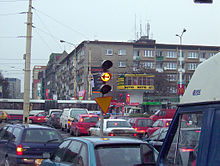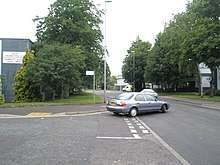Road rage
Road rage is aggressive or angry behavior exhibited by motorists. These behaviors include rude and offensive gestures, verbal insults, physical threats or dangerous driving methods targeted toward another driver or non-drivers such as pedestrians or cyclists in an effort to intimidate or release frustration. Road rage can lead to altercations, damage to property, assaults and collisions that result in serious physical injuries or even death. Strategies include long horn honks, swerving, tailgating, brake checking, and attempting to fight.
According to a study by the AAA Foundation for Traffic Safety that examined police records nationally, there are more than 1,200 incidents of road rage on average reported per year in the United States. Many of these incidents have ended with serious injuries or even fatalities. These rates rose yearly throughout the six years of the study.[1] A number of studies have found that individuals with road rage are predominantly young (33 years old on average) and 96.6% male.[2]
Legal status

In some jurisdictions, there can be a legal difference between "road rage" and "aggressive driving". In the U.S., only a few states have enacted special aggressive driving laws, where road rage cases are normally prosecuted as assault and battery (with or without a vehicle), or "vehicular homicide".
The legal definition of road rage encompasses a group of behaviors expressed while driving, or stemming from traffic-related incidents. The U.S. National Highway Traffic Safety Administration defines road rage as when "The operation of a motor vehicle in a manner that endangers or is likely to endanger persons or property." This definition makes the distinction that aggressive driving is a traffic violation and road rage is a criminal offense.[3][4]
Effects on drivers

A stressed driver's behavior depends on that driver's coping abilities. Generally, drivers who scored high on aggression tests used direct confrontation strategies when faced with stress while driving. Many drivers who experience road rage have admitted that they believe they commit more traffic violations.[4] Driving presents many stresses any time a person is behind the wheel because of high speeds and other drivers making different decisions. As stress increases, the likelihood of a person having road rage increases dramatically. Typically, younger males are most susceptible to road rage.[5] Most reported cases of road rage occur because of cutting in and out of traffic, lane changes, disputes over parking spots or rude gestures. According to the same report, 6.8% of road rage incidents result in death.[6]
According to one study, people who customize their cars with stickers and other adornments are more prone to road rage. The number of territory markers predicted road rage better than vehicle value or condition. Only the number of bumper stickers, not their content, predicted road rage.[7][8]
Common targets of road rage are driving instructors and learner drivers; as these road users tend to follow road regulations very closely, with learners prone to making more mistakes as they progress through their education towards taking a driving test, they are often antagonised by aggressive drivers. In 2019, British insurance provider Young Marmalade carried out a survey which found that 77% of driving instructors face regular abuse and intimidation from other road users while teaching students, and that 8% of learner drivers have abandoned learning to drive as a result of road rage they have been subjected to.[9]
.jpg)
Road rage is not an official mental disorder recognized in the Diagnostic and Statistical Manual of Mental Disorders (DSM). However, according to an article published by the Associated Press in June 2006, the behaviors typically associated with road rage can be the result of a disorder known as intermittent explosive disorder that is recognized in the DSM. This conclusion was drawn from surveys of some 9,200 adults in the United States between 2001 and 2003. The surveys were funded by the National Institute of Mental Health.[10]
Penalties
Road rage is a relatively serious act: It may be seen as an endangerment of public safety. It is, however, not always possible to judge intent by external observation, so "road ragers" who are stopped by police may be charged with other offences such as careless or reckless driving, or may be fined. Road ragers may be considered as criminals.[11][12]
Australia
In New South Wales, Australia, road rage is considered an extremely serious act. Any person who chases another motorist or shows intimidating and/or bullying towards another road user can be charged with predatory driving, a serious offence that can send the culprit to jail for up to five years. Offenders can also be fined A$100,000 and disqualified from driving, whether or not he or she intended to harm the victim physically. If the predatory driving results in a physical assault or harm, and/or the victim's car was intentionally damaged, penalties can be much more severe.
Additionally, most common-law countries prohibit common assault, which could apply to road rage where the personal safety of the victim is seen to be threatened. The common law regards assault as both a criminal and civil matter, leading to both public criminal penalties and private civil liabilities.
Germany
Road rage, insults and rude gestures in traffic can lead to fines and even prison sentences to drivers who shout insults or make offensive gestures while driving.[13]
New Zealand
In New Zealand, road rage in itself is not an offence, but drivers are usually charged with other offences committed during an act of road rage (usually assault or unlawful possession of an offensive weapon).[14] Drivers have a legal duty to take reasonable care to avoid endangerment of human life when operating a vehicle (s 156 Crimes Act 1961); failure to discharge this duty, such as an act of aggressive driving, can give rise to liability in criminal nuisance (s 146 Crimes Act 1961). Ramming a vehicle constitutes intentional or reckless damage to property, a criminal offence, with a maximum penalty of 7 years imprisonment (s 269 Crimes Act 1961). New Zealand courts currently have no powers to disqualify drivers who physically assault another road user.[15]
Singapore
Road rage is a crime in Singapore. When found guilty, the offender may be jailed for up to two years and/or fined up to $5,000 for causing damage.[16]
United Kingdom
In the UK, road rage can result in criminal penalties for assault or more serious offences against the person. The Public Order Act 1986 can also apply to road rage. Sections 4A and 5 of the 1986 Act prohibit public acts likely to cause harassment, alarm, or distress. Section 4 also prohibits threatening, abusive or insulting words or behavior with intent to cause a victim to believe that violence will be used against himself or another.[17]
United States
In some jurisdictions, such as the Commonwealth of Virginia, it is easier to prosecute road rage as reckless driving instead of aggressive driving simply because the burden of proof does not require "intent" to successfully convict.
It is likely that those causing serious injury or death during "road rage" incidents will suffer more serious penalties than those applicable to similar outcomes from simple negligence. In April 2007, a Colorado driver was convicted of first-degree murder for causing the deaths of two motorists in November 2005.[18][19] He will serve a mandatory sentence of two consecutive life terms.
Fourteen U.S. states have passed laws against aggressive driving. Only one state, California, has turned "road rage" into a legal term of art by giving it a particular meaning.[20] In Virginia, aggressive driving is punished as a lesser crime (Class 2 misdemeanor) than reckless driving (Class 1 misdemeanor).[21]
U.S. rankings
A 2007 study of the largest U.S. metropolitan areas concluded that the cities with the least courteous drivers (most road rage) are Miami, Phoenix, New York, Los Angeles, and Boston. The cities with the most courteous drivers (least road rage) are Minneapolis, Nashville, St. Louis, Seattle, and Atlanta.[22] In 2009, New York, Dallas/Fort Worth, Detroit, Atlanta and Minneapolis/St. Paul were rated the top five "Road Rage Capitals" of the United States.[23]
See also
Citations
- Mizell, Louis (March 1, 1997). "Aggressive Driving: Three Studies". National Transportation Library. AAA Foundation for Traffic Safety.
- Sansone, Randy A.; Sansone, Lori A. (July 2010). "Road Rage: What's Driving It?". Psychiatry. 7 (7): 14–18. PMC 2922361. PMID 20805914.
- "DOT HS 809 707". one.nhtsa.gov. Retrieved 2018-03-26.
- "What Causes Road Rage | Road Rage Defined | How to Deal with Road Rage". www.safemotorist.com. Retrieved 2016-04-22.
- Davis, Susan. "Road Rage: What It Is, How to Avoid It". WebMD. Retrieved 2016-04-22.
- Mann, Robert E.; Smart, Reginald G. (2002-10-01). "Deaths and injuries from road rage: cases in Canadian newspapers". CMAJ. 167 (7): 761–762. ISSN 0820-3946. PMC 126507. PMID 12389837.
- Kaplan, Matt (13 June 2008). "Bumper stickers reveal link to road rage". Nature. doi:10.1038/news.2008.889. Retrieved August 28, 2016.
- Szlemko, William J.; et al. (21 May 2008). "Territorial Markings as a Predictor of Driver Aggression and Road Rage". Journal of Applied Social Psychology. 38 (6): 1664–1688. doi:10.1111/j.1559-1816.2008.00364.x.
- "Stop dangerous driving around learner drivers". Driver Hub. Young Marmalade. Retrieved 9 February 2020.
- "'Road rage' gets a medical diagnosis". msnbc.com. 2006-06-05. Retrieved 2019-09-20.
- "Man charged over road rage incident". ABC News. March 31, 2010. Retrieved August 19, 2011.
- "McSherrystown man charged in road-rage incident". York Dispatch. 2011-08-10. Retrieved August 19, 2011.
- Road rage, insults, rude gestures can lead to fines, prison in Germany, Robert Szostek U.S. Army Europe Office of the Provost Marshal Public Affairs Office, November 24, 2009
- Sewell, Rochelle (July 29, 2017). "Road rage: Why human behaviour changes behind the wheel". Stuff. Retrieved March 14, 2018.
- Experts, Disha. 101 Essays for IAS/ PCS & other Competitive Exams. Disha Publications. ISBN 9789386320940.
- Chong, Elena. "Bus driver jailed one week for road rage". Straits Times. Retrieved 1 December 2015.
- "Public Order Act 1986". Statutelaw.gov.uk. Retrieved 2013-03-12.
- Nicholson, Kieran (2007-04-16). "Road-rage killer unrepentant". The Denver Post. Retrieved 2013-03-12.
- Road-rage driver offers blame at sentencing: Local News: The Rocky Mountain News Archived May 28, 2007, at the Wayback Machine
- "V.C. Section 13210 - Court-Ordered Suspension: Road Rage". Dmv.ca.gov. 2008-05-22. Archived from the original on March 2013. Retrieved 2013-03-12.
- Michael Winter (2015-02-20). "Suspect in Las Vegas road-rage killing knew victim". Usatoday.com. Retrieved 2015-11-02.
- "Road Rage Survey Reveals Best, Worst Cities". Theautochannel.com. Retrieved 2013-03-12.
- "Top 10 Best & Worst US Cities for Road Rage". Marketingcharts.com. 2009-06-24. Retrieved 2018-04-11.
General sources
- Controlling Road Rage: A Literature Review and Pilot Study Prepared for The AAA Foundation for Traffic Safety By Daniel B. Rathbone, Ph.D. Jorg C. Huckabee, MSCE June 9, 1999
- Road Rage: Causes and Dangers of Aggressive Driving (transcript of a portion of the official hearing record of the Committee on Transportation and Infrastructure – 1997)
- Summary Table on Aggressive Driving Laws, National Highway Traffic Safety Administration
- Survey of the States – Speeding, Governors Highway Safety Association
Further reading
- Eberle, Paul (2006). Terror on the Highway. Buffalo: Prometheus Books. ISBN 978-1-59102-379-1.
- Larson, John (1997). Steering Clear of Highway Madness. Wilsonville: Bookpartners. ISBN 978-1-885221-38-4.